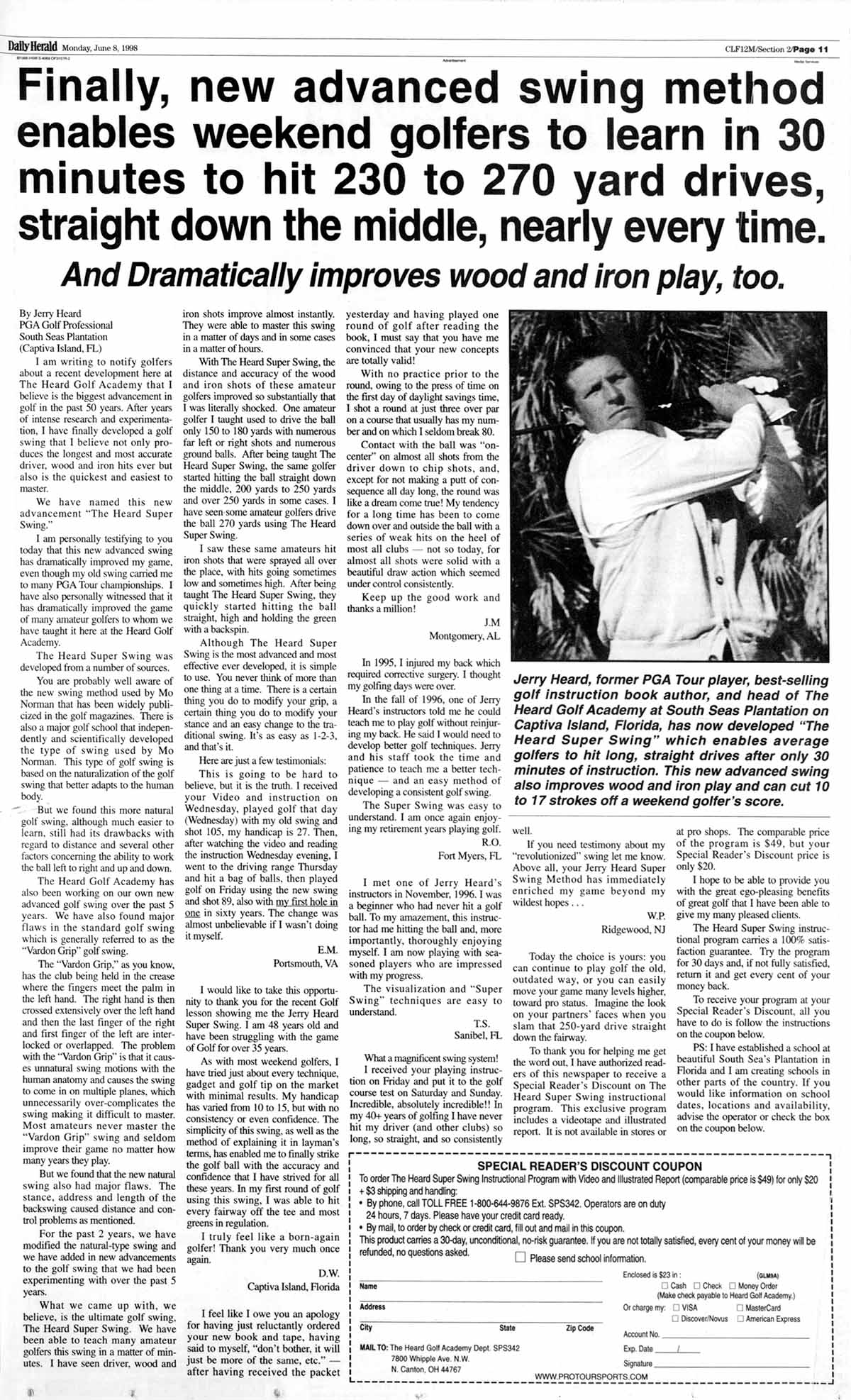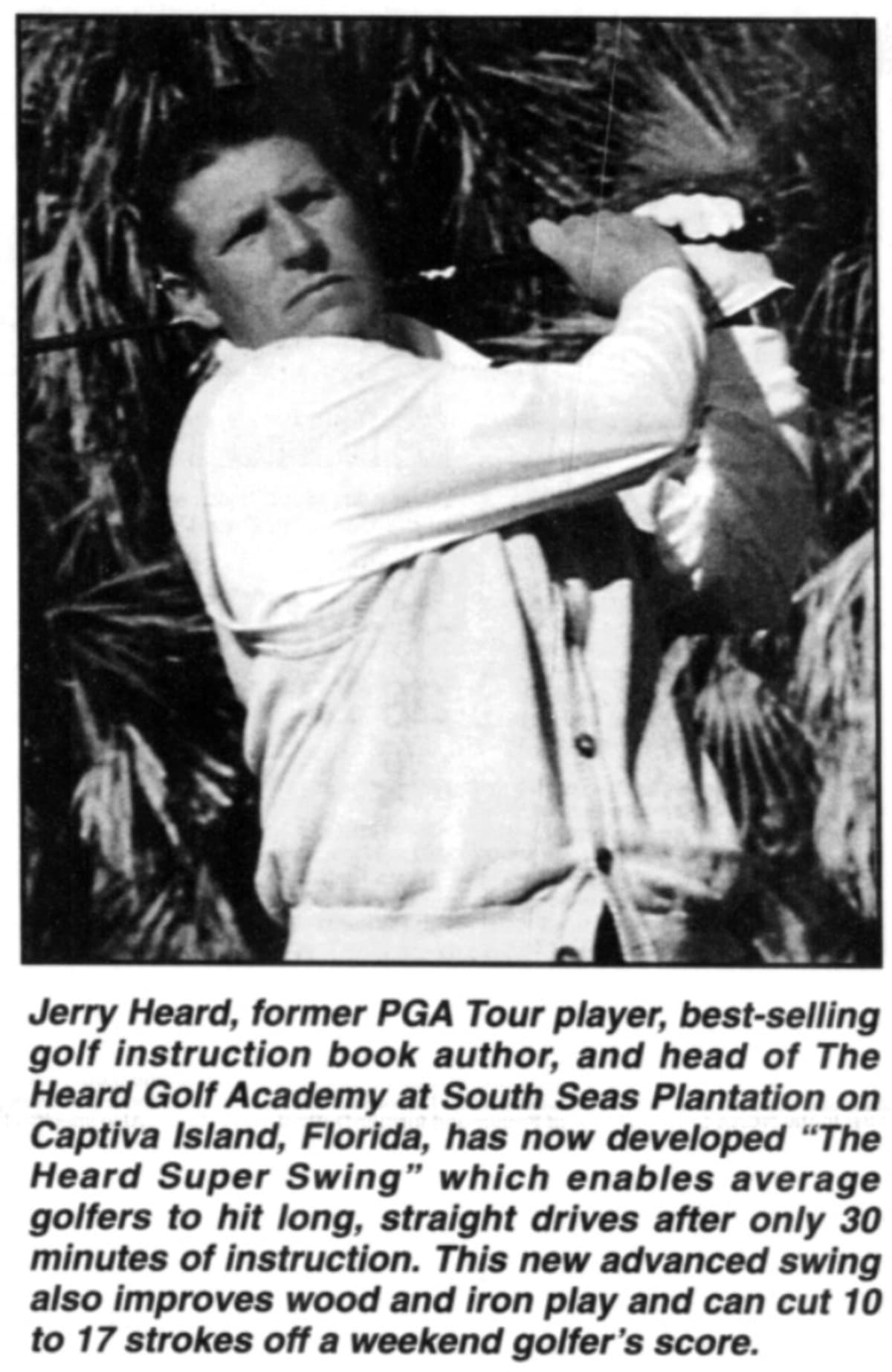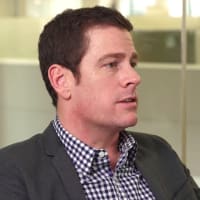How to turbocharge your golf game (and your copywriting)
(By the way, to get articles like this free in your inbox, subscribe to our newsletter.)
Take this 1998 newspaper ad as an example. As copywriters, we want to look for the bones—the structure of the piece and the persuasive elements that combine to deliver the message.

Let’s look at some of the bones in this ad and see how they persuade golfers to take out their credit cards.
Seven standout persuasion elements in this ad
1. The headline speaks directly to the audience
For weekend golfers who are short on both time and distance, the headline is magnetic:

Enthusiastic golfers invest thousands in equipment, lessons, and fees. Few among them could resist a promise like this—assuming the claims prove true and the price is affordable.
Readers will likely glance at the offer and see it’s only $20, leaving proof as the biggest remaining barrier between the ad and their credit cards.
2. An abundance of proof builds trust
Look at the proof packed into this ad! It ran in a medium where space cost a lot, and yet it contains six long testimonials:

Even today, when digital space is essentially limitless, few websites include even a handful of testimonials on their key pages. (With so many ways to build proof, failing to include it is a missed opportunity.)
These testimonials do a lot of work: Not only are they geographically dispersed, but they address unspoken objections like: “…having said to myself, ‘don’t bother, it will just be more of the same…’”
The testimonials also represent a mix of beginners and experienced golfers, offering relatable perspectives for everyone in the target market.
3. The caption restates the value proposition
The great copywriter Gary Bencivenga teaches that people naturally look at an image, and then their eyes go to the caption beneath it.

This caption makes maximum use of that phenomenon by restating most of the key points:
- Jerry Heard is a legitimate golf pro, having been on the PGA Tour.
- He’s also a best-selling author and head of a golf academy.
- He developed a special swing that works after only 30 minutes.
- This swing will cut 10 to 17 strokes off the score of a weekend golfer.
If readers only scan the headline, image, and caption, they may already feel ready to buy. It’s an excellent example of creating paths for both readers and scanners.
4. The process is given a name
Another legendary copywriter, Eugene Schwartz, wrote one of the most admired books on copywriting, Breakthrough Advertising. (It’s out of print and routinely sells for $200-400 on Amazon.)
One of Schwartz’s principles is to “name the mechanism,” and we can see it on show here.
In the ad, the new swing is not called “a better swing that Jerry Heard developed.” Instead, it’s called: “The Heard Super Swing.”
When you give a process or technique its own name, it takes on a life of its own. At CRE, we eat our own dog food and long ago named our process for growing businesses.
5. Insider language engages the reader
Notice this clever approach in the ad:
“You are probably well aware of the new swing method used by Mo Norman that has been widely publicized in the golf magazines.”
This wording respects the reader as an insider. Even if they aren’t familiar with Mo Norman or golf magazines, this “shop talk” builds rapport without sounding condescending.
We see the same principle at work later:
“The ‘Vardon Grip,’ as you know, has the club being held in the crease where the fingers meet the palm in the left hand.”
Think about that language: If you knew about the Vardon Grip, you wouldn’t need it described. It’s an elegant way of explaining while maintaining the feeling of merely chatting among golf insiders.
6. Future pacing sparks desire
Playing a great round of golf may be nice for personal satisfaction, but golf is a social game. The ad prompts readers to envision success:
Today the choice is yours: you can continue to play golf the old, outdated way, or you can easily move your game many levels higher, toward pro status. Imagine the look on your partners’ faces when you slam that 250-yard drive straight down the fairway.
Take a moment and think about your product or service. How would you complete a sentence that said: “Imagine the look on [someone’s face] when you…”
Whether your customers are buying a B2B SaaS solution or a backyard shed, they aren’t purchasing just a product; they’re buying the transformation it brings.
7. The upsell is not a hard sell
We all have seen infomercials where we’re told: “That’s not all, folks! If you order in the next 13 minutes….” That approach may work, but it’s worth testing the softer upsell of the type in this ad:
“I have established a school at beautiful South Sea’s Plantation in Florida…If you would like information on school dates…advise the operator or check the box on the coupon.”
If the ad has done its job, no arm-twisting is necessary; readers will naturally want to know more.
Five simple copy changes we would test

At CRE, we apply a comprehensive methodology to create bold tests and wins for clients. Our unique Wins Database holds 19 years of successful tests, many of which prove how slight copy changes can put much more money into our clients’ pockets.
Here are a few copy tests we might run on the ad above:
1. Strengthen the guarantee
Instead of stating the guarantee in a negative: “Try the program for 30 days and, if not fully satisfied…” it would be worth testing if more future-pacing may increase conversions:
“Take a full month to try the Heard Super Swing—not that you’ll need that much time. You must be blown away at how this has boosted your game, or simply return it for a full refund.”
2. Be explicit about shipping-cost refunds
Readers are told they will get “every cent of your money back” but may remember how many vendors exclude shipping from their calculations. If we’re not one of them, and we truly mean “every cent,” then we should say so:
“You’ll get every cent of your money back, including shipping costs.”
3. Say how prompt the refund will be
People are also accustomed to being nickel-and-dimed for refunds and seeing fine print with language like: “Refunds require 2-4 weeks to appear on your statement.” We may win more sales by saying:
“You’ll get your no-questions-asked refund within 48 hours.”
4. Make the price seem trivial
We read: “…your special Reader’s Discount price is only $20.” We would test a comparison:
“…your special Reader’s Discount price is only $20. That’s about the cost of a dozen golf balls or a round in the clubhouse.”
5. Frame the cost as an investment
Costs are things like hamburgers that get consumed; investments are expenses we expect to keep giving back:
“For an investment of just $20 and 30 minutes of your time, you just might make the biggest leap in your golf game yet.”
Turbocharge your copywriting skills
Readers of this ad may have “dramatically improved” their golf game, but thirty years later, we get to benefit in a different way.
Whether you’re crafting long-form ads, emails, or persuasive product pages, the techniques above can help you dramatically improve your copy. But the real win is the developing mindset—the habit of analyzing successful ads, identifying effective patterns, and testing them with your audience.
Great copywriting is hard work, but it’s not a black art… and examples worth learning from are all around.
How much did you like this article?
What’s your goal today?
1. Hire us to grow your company
We’ve generated hundreds of millions for our clients, using our unique CRE Methodology™. To discover how we can help grow your business:
- Read our case studies, client success stories, and video testimonials.
- Learn about us, and our unique values, beliefs and quirks.
- Visit our “Services” page to see the process by which we assess whether we’re a good fit for each other.
- Schedule your FREE website strategy session with one of our renowned experts.
Schedule your FREE strategy session
2. Learn how to do conversion
Download a free copy of our Amazon #1 best-selling book, Making Websites Win, recommended by Google, Facebook, Microsoft, Moz, Econsultancy, and many more industry leaders. You’ll also be subscribed to our email newsletter and notified whenever we publish new articles or have something interesting to share.
Browse hundreds of articles, containing an amazing number of useful tools and techniques. Many readers tell us they have doubled their sales by following the advice in these articles.
Download a free copy of our best-selling book
3. Join our team
If you want to join our team—or discover why our team members love working with us—then see our “Careers” page.
4. Contact us
We help businesses worldwide, so get in touch!
© 2025 Conversion Rate Experts Limited. All rights reserved.















